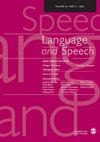日语第一语言节奏对英语第二语言语音的影响
IF 1.1
2区 文学
Q3 AUDIOLOGY & SPEECH-LANGUAGE PATHOLOGY
引用次数: 0
摘要
本研究旨在通过评估日语 L2 英语使用者的语音节奏与母语使用者的语音节奏有何不同,来研究 L1 的语音节奏是否会影响 L2 的语音。我们之所以选择日语和英语,是因为这两种语言在语音特性上存在明显差异,而语音特性很可能会影响语音节奏。语音节奏是通过元音和辅音间隔的变异性来测量的,使用的是速率归一化节奏度量(VarcoV 和 VarcoC;nPVI-V 和 nPVI-C)和 %V。研究使用了 10 位以英语为母语的澳大利亚人的英语口语句子录音;以及 10 位以英语和日语为母语的日本人(他们的英语口语经验有限)的英语口语句子录音。实验 1 比较了母语为英语(通过测量 20 个句子中的 1,750 个元音和 3,093 个辅音)和母语为日语(通过测量 10 个句子中的 1,923 个元音和 2,097 个辅音)的节奏。结果表明,与英语相比,在所有测量中,日语辅音和元音音程的持续时间变异性都较低。在实验 2 中,我们使用 40 个句子(包括实验 1 中的 20 个句子)研究了 L1 和 L2 英语的节奏特点。结果表明,与第一语言(澳大利亚英语)相比,第二语言(日语)的元音和辅音音程变化较小,这与实验 1 的结果一致。总体而言,结果与第一语言(日语)语音节奏影响第二语言(英语)语音的观点一致。本文章由计算机程序翻译,如有差异,请以英文原文为准。
Impact of Japanese L1 Rhythm on English L2 Speech
The study aimed to examine whether L1 speech rhythm affects L2 speech by assessing how the speech rhythm of Japanese L2 English speakers differed from native speakers. We chose Japanese and English because they differ markedly in the phonological properties that likely contribute to speech rhythm. Speech rhythm was measured by the variability of vowel and consonant intervals using rate-normalized rhythm metrics (VarcoV and VarcoC; nPVI-V and nPVI-C) and %V. The study utilized recordings of spoken sentences in English by 10 native Australian English speakers; and in English and also in Japanese by 10 native Japanese speakers (who had limited experience in speaking English). Experiment 1 compared the rhythm of L1 English (by measuring 1,750 vowels and 3,093 consonants from 20 sentences) and L1 Japanese (1,923 vowels and 2,097 consonants from 10 sentences). The results showed that for all measures, Japanese had reduced durational variability in both consonant and vowel intervals compared with English. In Experiment 2, we examined the rhythm characteristics of L1 and L2 English using 40 sentences (including the 20 in Experiment 1). The results showed that vowel and consonant intervals were less variable in L2 (Japanese English) than in L1 (Australian English) speech, mirroring the results of Experiment 1. Overall, the results are consistent with the proposal that L1 (Japanese) speech rhythm influenced L2 (English) speech.
求助全文
通过发布文献求助,成功后即可免费获取论文全文。
去求助
来源期刊

Language and Speech
AUDIOLOGY & SPEECH-LANGUAGE PATHOLOGY-
CiteScore
4.00
自引率
5.60%
发文量
39
审稿时长
>12 weeks
期刊介绍:
Language and Speech is a peer-reviewed journal which provides an international forum for communication among researchers in the disciplines that contribute to our understanding of the production, perception, processing, learning, use, and disorders of speech and language. The journal accepts reports of original research in all these areas.
 求助内容:
求助内容: 应助结果提醒方式:
应助结果提醒方式:


